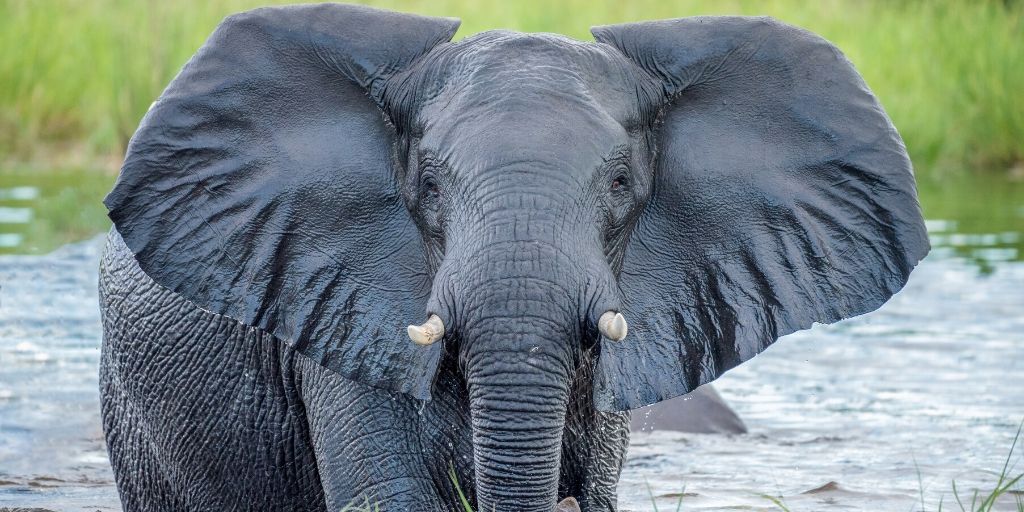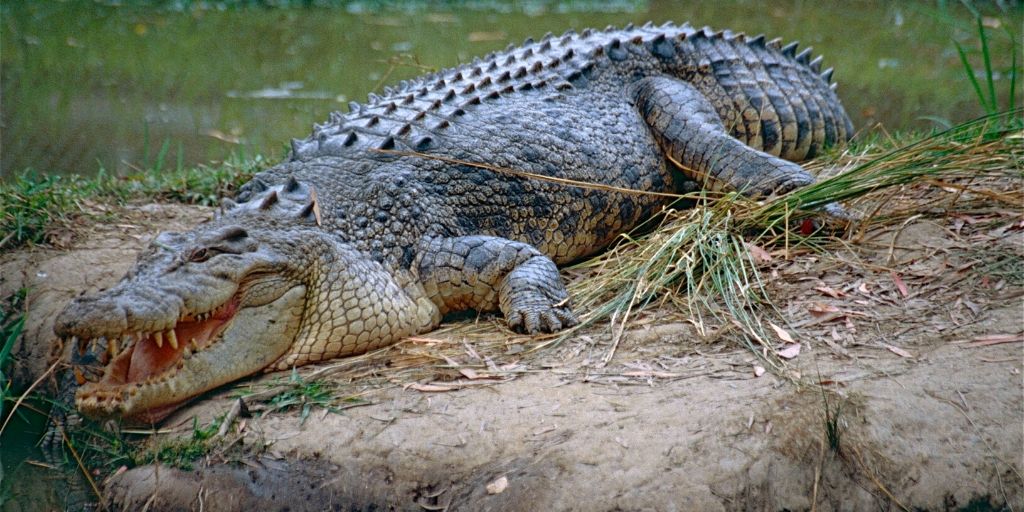What Is The Second Largest Land Animal
Looking for the biggest animals in the world? Then you're in the right place!
Animals come in all shapes, sizes, and types, so when trying to empathise what the largest animals are it'south of import to specify exactly how we ascertain "largest", and which types of animals we're looking at.
Are we looking at the tallest, longest, heaviest of all animals? Or focussing specifically on the biggest land animals, largest living animals, or including all the largest animals that have ever lived on earth, at whatever time?
This page focuses on listing and describing the largest animals by size and category. The first section lists the largest animals by type, and the 2nd department type lists the 10 largest land animals live today past weight. Nosotros too have this article on the heaviest animals alive today.
And so, with this in heed, below is our list of the world's biggest animals:
The biggest brute on the planet (ever):
Bluish Whale (Balaenoptera musculus)

The largest living animal on the planet, the blue whale (Balaenoptera musculus)
What is the biggest animal in the earth? The blue whale.
In terms of absolute size, the blue whale is not simply the largest living brute, only also the largest fauna that has ever existed – reaching a length of around thirty meters, and a weight of around 180 tons. A blueish whale heart alone can weigh as much every bit a machine, and their tongue as much every bit an elephant. Newborn blue whales counterbalance around 3 tons, and the biggest blueish whale ever recorded was an astonishing 190 tons!
Biggest country animal in the world, past weight:
African Bush Elephant (Loxodonta africana)

African bush elephant, the largest animals on land
The largest animal on land is the African bush elephant (one of two African elephant species, along with the African woods elephant), which can grow to 4.5 meters tall at the shoulder, six meters long, and weigh up to 6,000 kg. These enormous beasts are currently listed as vulnerable in the IUCN Crimson List of Threatened Species, and one of Africa's endangered animals.
Biggest state animal past height:
Giraffe (Giraffa)

A family of giraffes, amongst the largest animals globally
Clocking in at half-dozen meters tall, the giraffe is the largest land animal by some way if we're measuring height. Their necks solitary can reach close to 2 meters long, and their tounges a handy half meter long! Giraffe calves accept a 15 month gestation period, and when they're born (unusually for a mammal they come out feet first) are already ii meters tall.
Biggest bird past wingspan:
Wandering Albatross (Diomedea exulans)

The largest bird in the world by wingspan – the Albatross
With a wingspan of upwards to three.7 meters wide, the wandering albatross is the largest living bird on World when measuring wingspan.
Their enormous wingspan allows the albatross to glide for long distances without the need to flap their wings, which in turn helps define their lifestyle every bit birds which spend well-nigh of their lives in flight, landing only to breed and feed.
Biggest bird by height and weight:
Mutual Ostrich (Struthio camelus)

Family of enormous common ostriches
The mutual ostrich is the biggest bird in the globe, with an average height of over 2 meters (sometimes as tall every bit two.7 meters) and a weight of upwardly to 160 kg. At this size, the ostrich is, of class, a flightless bird, simply can outrun enough of other fast animals with its top speed of 69 km per hour. Their long, powerful legs double up every bit defensive weapons which pack a powerful kicking to would-be predators.
Fun ostrich fact – they are able to survive without water for days, generating h2o internally and extracting water from vegetation.
Biggest toothed carnivore:
Sperm Whale (Physeter macrocephalus)

Sperm whale – largest carnivore in the world
Whilst the world's largest animal – the blue whale – filter-feeds krill, so is technically the largest carnivore of all fourth dimension, the sperm whale is the largest living toothed whale and the largest toothed predator.
These whales grow up to 20 meters in length (10 meters shorter than a blue whale) and can counterbalance 60 tons, diving over a kilometer to hunt and feed on giant and medium-sized squid, along with rays and octopus.
Biggest land carnivore:
Polar Conduct (Ursus maritimus)

The largest country carnivore – the polar bear
It's a shut call betwixt the Kodiac comport and the polar bear for the title of the earth'southward biggest carnivore, and in truth, it's very difficult to pick the winner as size-wise they're and then similar… merely we've gone for the polar bear.
Developed males weigh an average of 700 kg and stand around iii meters tall when standing on their hind legs. Polar bears are born on land but spend about of their life on sea ice, hunting seals on the water ice, and in the freezing arctic waters. Due to habitat erosion, polar bears are ane of the well-nigh endangered animals on this listing.
Biggest fish in the body of water:
Whale Shark (Rhincodon typus)

The biggest fish – the whale sark – surrounded by smaller fish
The largest living fish in the world is the – somewhat confusingly named – whale shark, which can reach up to 12 meters long, and weigh in at around xix tons. The whale shark is found in tropical waters around the earth, and equally with nearly whales is a filter feeder, eating krill, plankton fish eggs, and small fish.
Biggest reptile in the world:
Saltwater Crocodile (Crocodylus porosus)

A basking crocodile
The largest – and probably scariest – living reptile is the saltwater crocodile. This prehistoric monster can grow to over seven meters in length and counterbalance up to half a ton. Their healthy population is distributed around salt and brackish waters in parts of Asia, Australia, and India.
Due to their size (and teeth!), 'salties' are apex predators, able to prey on water buffalo, sharks, and pretty much anything else that comes into striking distance. One of the nearly dangerous animals in the earth, the saltwater crocodile is like to its freshwater cousin in the way it ambushes its casualty and drowns information technology, though often and then swallows information technology whole rather than violent out chunks.
Biggest snake in the globe, past length:
Reticulated Python (Malayopython reticulatus)

Reticulated python close up
Of all snake species, it's the reticulated python that is the longest on record, with a Malaysian specimen defenseless on a edifice site in 2016 measuring 8 meters in length. These non-venomous, constricting snakes are found across South and S Eastern asia in rain forests, woodlands, and grasslands. Their diet consists primarily of small and medium-sized mammals, only they've been known to consume bears… and humans!
Biggest serpent in the world by, weight:
Green Anaconda (Eunectes murinus)

Due south America'southward green anaconda, the largest living snake
The green anaconda can grow to 7 meters long, and with their 30 cm diameter can weigh up to 250 kg. Whilst being a slow animal on land, these giant snakes are congenital for water, and are found in swamps, marshes, and streams across South America.
With their eyes and nose on the top of their heads, anacondas tin can lie almost completely submerged to look for prey, and due to their size tin comfortably have on wild pigs, deer, and even jaguars.
Biggest dolphin in the globe:
Orca (Orcinus orca)

Orca are as well known every bit killer whales, though they are actually the largest creature in the Delphinidae family unit of oceanic dolphins. At 8 meters long and five,400 kg, an average-sized orca tin eat up to 230 kg of food a day. These apex predators take no predators, and hunt in family pods, targetting anything from fish to adult whales.
Orcas are found in all of the world'southward oceans, with some hunting techniques and song communication specific to individual pods, and passed on through the generations.
Biggest rodent in the world:
Capybara (Hydrochoerus hydrochaeris)

Capybara, the world's biggest rodent
Take you e'er seen an 80 kilogram rodent? If not, you've probably non ready eyes on the capibara, the world'south biggest rodent, Native to S American wetlands the capibara stands around 60 centimeters loftier and i.2 meters long, looking like a guinea hog on steroids. Unlike other rodents, the capibara has no tail and comes with webbed feet to help it get around its favored watery terrain.
The ten biggest land animals by weight:
1. African bush-league elephant: Upwards to 6,900 kg
2. Asian elephant: Up to 4,600 kg
iii. White rhinoceros: Up to 3,600 kg
four. Indian rhinoceros: Up to 2,132 kg
five. African forest elephant: Upwards to two,300 kg
6. Black rhinoceros: Upwards to 2,900 kg
vii. Hippopotamus: Upwards to 2,000 kg
8. Giraffe: Upward to i,395 kg
9. Cape buffalo: Up to ane,000 kg
10. Gaur: Upwardly to 940 kg
And that's your lot for the globe's biggest animals. What do you think – did the size of any of these animals surprise you? Or take you met whatsoever of these huge animals in the wild? Delight practise share your experiences in the comments section below!
Source: https://safarisafricana.com/biggest-animals-in-the-world/
Posted by: fossutall1944.blogspot.com

0 Response to "What Is The Second Largest Land Animal"
Post a Comment